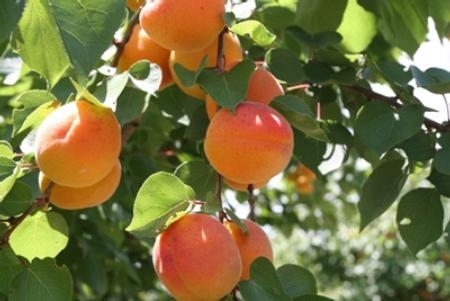
Apricots have been grown in the fertile crescent of Persia for thousands of years. The colonists brought the apricot to North America, but most of the stock of today’s production comes from seedlings carried by the Franciscan friars who built the missions and brought much of Spain’s agriculture to California.
In recent years I have heard many disappointed comments at that first bite of a fresh apricot, and I was curious to check with University of California pomologists and USDA Agricultural Research Station specialists to see what progress was being made in bringing more flavorful apricots to consumers. Five different pomologists indicated that market produce buyers tend to primarily value color, size and firmness over the flavor of apricots. The earlier the produce buyers can get them into the grocery store, the more highly they are valued, so they are often harvested before the fruit’s flavor has a chance to develop. The experts I checked with all said they NEVER bought apricots anywhere except a farmer’s market or roadside stand.
The varieties most commonly grown in California are “Patterson”, “Tilton” and “Apache,” and they are selected by growers because of their early harvest dates, large size, attractive color, longer shelf life, and their ability to be used for either fresh or canning applications. Tom Gradziel, a UC Davis professor of genetics and breeding of the Prunus species said, “In the Central Valley, most apricots are still going for processing. Therefore a dual market (processing or fresh) variety such as Patterson is often preferred. It has excellent color, size, and firmness, but tastes like cardboard."
The varieties that the pomologists included in their list of favorites are “Royal Blenheim,” “Robada,” “Katy,” “Primarosa” and “Derby.” Craig Ledbetter, a geneticist working with apricot breeding at the Parlier USDA Agricultural Research Service Center said, “We hear so much about flavor, but I don’t think flavor will be coming to the grocery stores unless in the form of overripe fruit. Here we breed for a sugar/acid balance. We have many breeding selections that taste absolutely fabulous, but are a bit smaller than growers desire. Honestly, they don’t even want to look at ‘small’ fruit. It is a pity!”
Selecting apricots. Apricots do not develop more flavor after they are picked, so select fruit that are completely yellow, deepening toward orange. The subtle, sweet scent of apricot is a good indicator that the inside will taste just as good.
Storing apricots. Keep them on the counter if you will eat them within 2 to 3 days, otherwise store ripe apricots in the refrigerator in a perforated plastic bag.
How to enjoy apricots. Apricots have a pit in the center that is easily separated from the flesh. After washing the fruit, cut in half along the seam and remove the pit. Enjoy the whole fruit, or prepare in tarts, breads, jams, glazes for meats, salsa, or dry them in a dehydrator.
Apricot Tart
Pastry.
1 ¼ c. all-purpose flour
½ tsp. salt
1 Tbls. granulated sugar
½ tsp. almond flavoring (optional)
½ c. unsalted butter, chilled
2 Tbls. Ice water

Apricot filling.
½ c. granulated sugar (or less if the apricots are sweet)
1 Tbls. cornstarch
Dash of salt
1 ½ lbs. (or 10 medium-large) fresh, ripe apricots, pitted and sliced into 1/4” slices
Place sugar, cornstarch and salt into a bowl and stir well, add sliced apricots and toss gently.
Remove pastry from the refrigerator, place apricot filling in the center of the pastry, leaving a 2” border around the edge. Gently fold the pastry border up on top of the apricots, folding the pastry up around the outside edges of the fruit and pinching folds to form a round tart. Seal any cracks in the sides and bottom of the pastry so the juice doesn’t leak out on the baking sheet. Leave the fruit showing in the center of the pastry. Sprinkle with a handful of sliced almonds if desired.
Bake at 375 degrees F for 40-45 minutes, or until golden brown.
Excellent served with vanilla ice cream.
University of California Resources:
- Recommendations for Maintaining Postharvest Quality of Apricots
- Storing Fresh Fruits and Vegetables for Better Taste
- Apricot Information: Fruit & Nut Research and Information Center